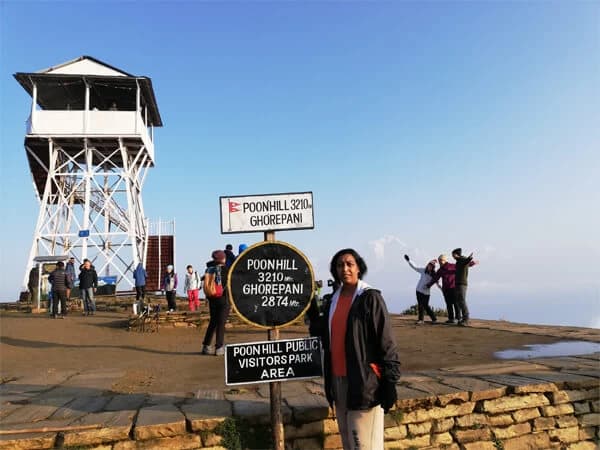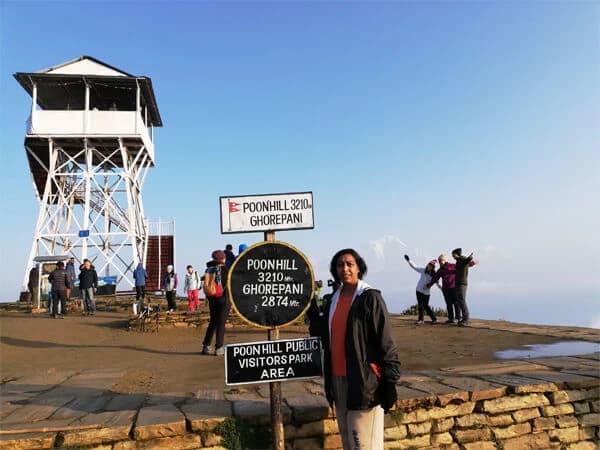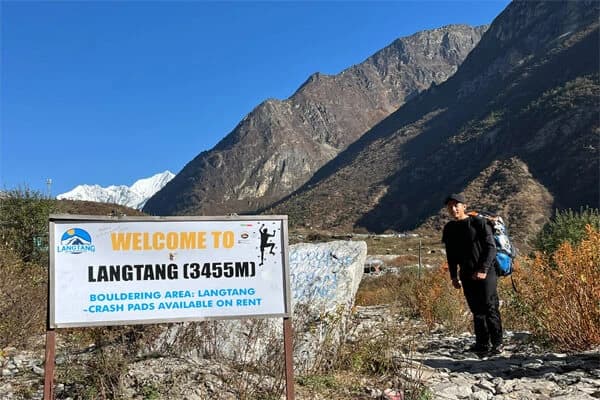"How much does the Ghorepani Ghandruk Trek cost?" is a common query. That is the main focus of this blog. We will break everything down into easy-to-understand terms so you can plan your trek stress-free.
The Ghorepani Ghandruk Trek is a short but stunning trek in Nepal's mountains. For those with limited time who yet like to see snow-capped mountains, green forests, and charming villages, it is ideal. One of the nicest parts of the trip is seeing the sunrise over the mountains, which is why many people trek to Poon Hill!
Permits, transportation, food, lodging, guides, porters, and other expenses will be covered. We'll also provide you with money-saving advice and provide sample budgets for various trekker types, including those who are going on a tour and those who go alone.
This blog was created to make it simple for students, families, and novices to comprehend the entire expense of the Ghorepani Ghandruk Trek. This advice will help you prepare effectively and have a fun journey without breaking the bank, whether you want to travel alone or with our company.
Ghorepani Ghandruk Trek Overview
Ghorepani Ghandruk Trekking is one of the small beautiful adventure treks in Nepal. “It’s great for those who want to experience the Himalayas but don’t have much time.” This trek typically lasts 4 to 6 days depending on your walking pace and how long you would like to spend in each village.
The trek begins at Nayapul, which is 1-2 hours away from Pokhara by car. Then you walk to Tikhedhunga, Ulleri and Ghorepani. Early morning,you shall trek up to Poon Hill (3,210m). Poon Hill is an iconic Viewpoint and Most Famous area of the Trek. From the summit, you can see the sun rising on top of giants like Annapurna and Dhaulagiri.
Beyond Poon Hill, the trail descends to Tadapani, then to Ghandruk a beautiful Gurung village of stone houses and smiling people. And from Ghandruk, you trek back to the road and drive on to Pokhara.
This trail doesn’t go very high, so it’s great for novice trekkers and families. The starting point is Nayapul (1,070 meters), and the ending point is Poon Hill (3,210 Meters). From that height very little altitude risk exists, but it isn't that high.
You walk roughly 4 to 6 hours a day. The trails wind through forests and rivers and pass by tranquil mountain villages. You’ll pass rhododendron trees, monkeys and numerous birds along the way. It's a relatively short and safe trek with some awesome views. It’s one of the great ways to experience the Himalayas without going too high or too far.
Ghorepani Ghandruk trek breakdown cost
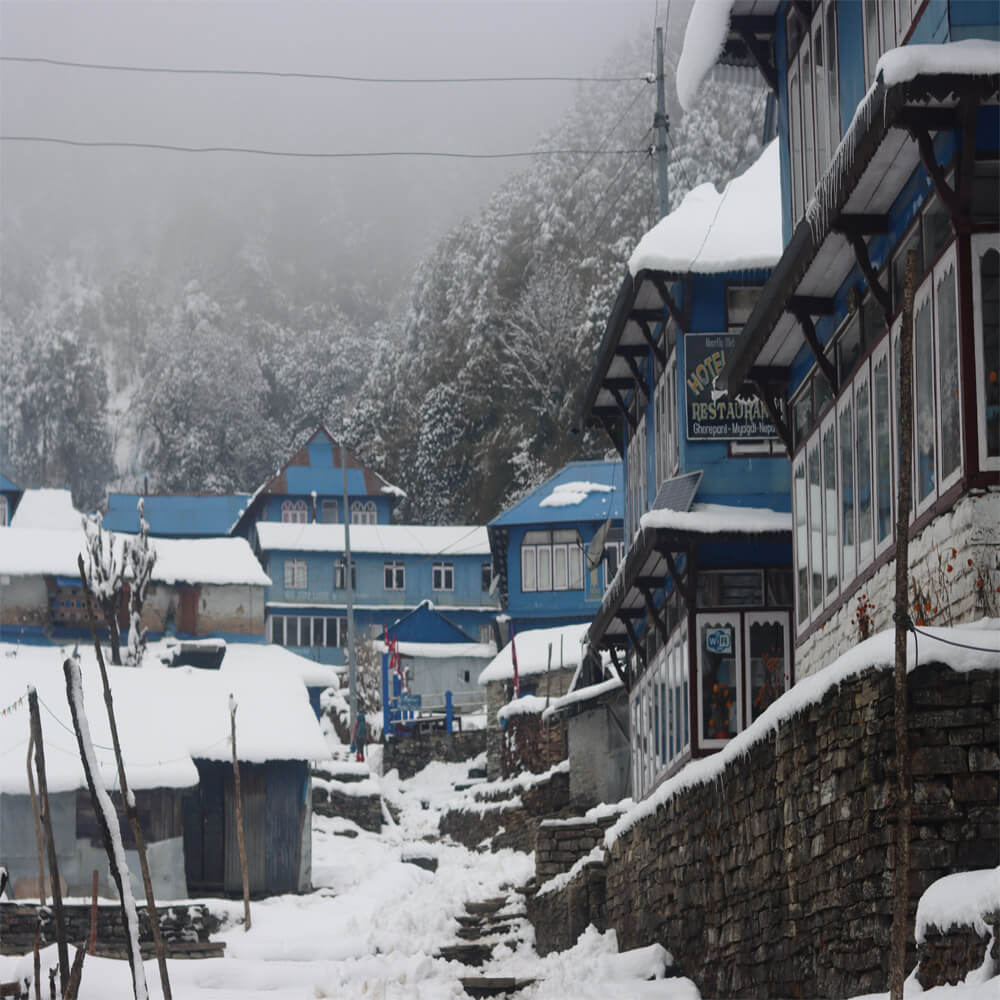
Permits, transportation, teahouse lodging, daily meals, and a guide or porter are some of the variables that affect the Ghorepani Ghandruk Trekking expenses. Rental equipment, hot baths, Wi-Fi, and individual expenditures like drinks, snacks, and modest tips are additional fees.
Ghorepani Ghandruk Trek Permit Fees
A trekking permit is like a ticket that allows you to walk in specified parts of the mountains. The government of Nepal uses the money from permits to protect nature and support local villages. If you wish to do the Ghorepani Ghandruk Trek, you need two permits.
Annapurna Conservation Area Permit (ACAP)
The first permit you need is called the Annapurna Conservation Area Permit. This region is protected, and the permit helps maintain the forest, animals, and paths safe and clean. Every trekker must have this permit, even if you are going for just a few days. The cost for foreigners is about 3,000 Nepali Rupees, which is around 25 US dollars.
TIMS Card (Trekkers' Information Management System)
The TIMS card is the second permit. Your name, passport number, and itinerary are all on this card. In an emergency, it aids rescue crews and the government in tracking down trekkers. It also makes trekking in Nepal safer. The TIMS card costs roughly 2,000 Nepali Rupees, which is equivalent to $15 USD.
Both permits are available in Pokhara and Kathmandu. We will provide the permits for you if you reserve your trek with our company, Nepal Trekking Routes. All you have to do is present them with a copy of your passport and a photo the size of it.
Permits are essential for both safety and the benefit of the local population and environment in the trekking region. You could be required to present your permits at checkpoints, so always keep them with you while trekking. You are prepared to start your Ghorepani Ghandruk adventure with your TIMS card and ACAP in hand!
Ghorepani Trek price details for Transportation
From Pokhara to Nayapul
Typically, the Ghorepani Circuit Trek also called Annapurna sunrise view trek starts in the tiny village of Nayapul, which is close to Pokhara. It will take a drive to get there. Public buses and private taxis or jeeps are the two most popular modes of transportation. The less expensive option is to take the public bus. The road is a little hilly but incredibly picturesque, and the ride takes roughly two to three hours. Simple and sometimes packed, buses are a good option if you're on a tight budget.
You can get a private cab or jeep if you desire a quicker and more pleasant travel. Although private vehicles are more expensive, they are ideal for families or small groups. You are free to depart early and take your time enjoying the journey. If you want to pause for photos along the road or have a lot of bags, this is also useful.
From Ghandruk to Pokhara
You will need to return to Pokhara once the trip concludes in Ghandruk. Once more, you have two primary options: walk to Kimche or Nayapul and take a bus or taxi from there, or take a local jeep from Ghandruk.
In Ghandruk, you can find local jeeps that will return you to Pokhara in four to five hours. Although there are some hard spots on the route, the scenery is breathtaking. Although Jeep trips cost more than buses, they save time and energy, particularly if you're exhausted from the trek.
The overall cost of transportation for the entire journey (to and from the trek) can vary from $15 to $60, depending on whether you take a bus, jeep, or cab. One excellent strategy is to split expenses and increase the enjoyment of the trip by travelling in a group or with friends.
Food and Accommodation Costs Ghandruk Circuit Trek
Ghorepani ghandruk Trek Accommodation Cost
You will stay in teahouses, which are tiny hotels, while on the Ghorepani Ghandruk Trek. The locals built these basic homes so that trekkers might sleep and rest. The tiny rooms in each teahouse typically have two beds. Other visitors might have to use the same restroom as you.
Staying in a teahouse doesn't cost a much. The cost of a night in lesser settlements might range from $5 to $8. The cost may increase to $10 or more as you ascend the mountain, like in Ghorepani, particularly during peak seasons. You can get a cheaper accommodation at several teahouses if you have breakfast and dinner there. Teahouses are not upscale, yet they are comfortable and tidy. Even though they provide blankets, it's still a good idea to pack your own sleeping bag.
Ghorepani Ghandruk Trek Food Cost
Every meal you consume will be in the teahouses. The food is straightforward but satisfying. Dal Bhat, which consists of rice, lentil soup, and a few vegetables, is the most well-liked dish. It is fantastic for trekking and offers you a lot of energy. Refills are free in numerous locations.
Pancakes, eggs, or toast with tea are typical breakfast fare. Options for lunch and dinner include potatoes, fried rice, soup, and noodles. Meals cost between $3 and $6, although they may cost more in more expensive locations. Water is also crucial. As you go up, the price of bottled water increases. Bringing tablets or a water filter can help you save money.
Total Price per Day
You might spend $20 to $30 a day on food and accommodation. You will have everything you need to enjoy your adventure, and it is not overly costly.
Ghorepani Ghandruk Trek Guide and Porter Costs
Hiring a Guide for Ghorepani Ghandruk Trekking
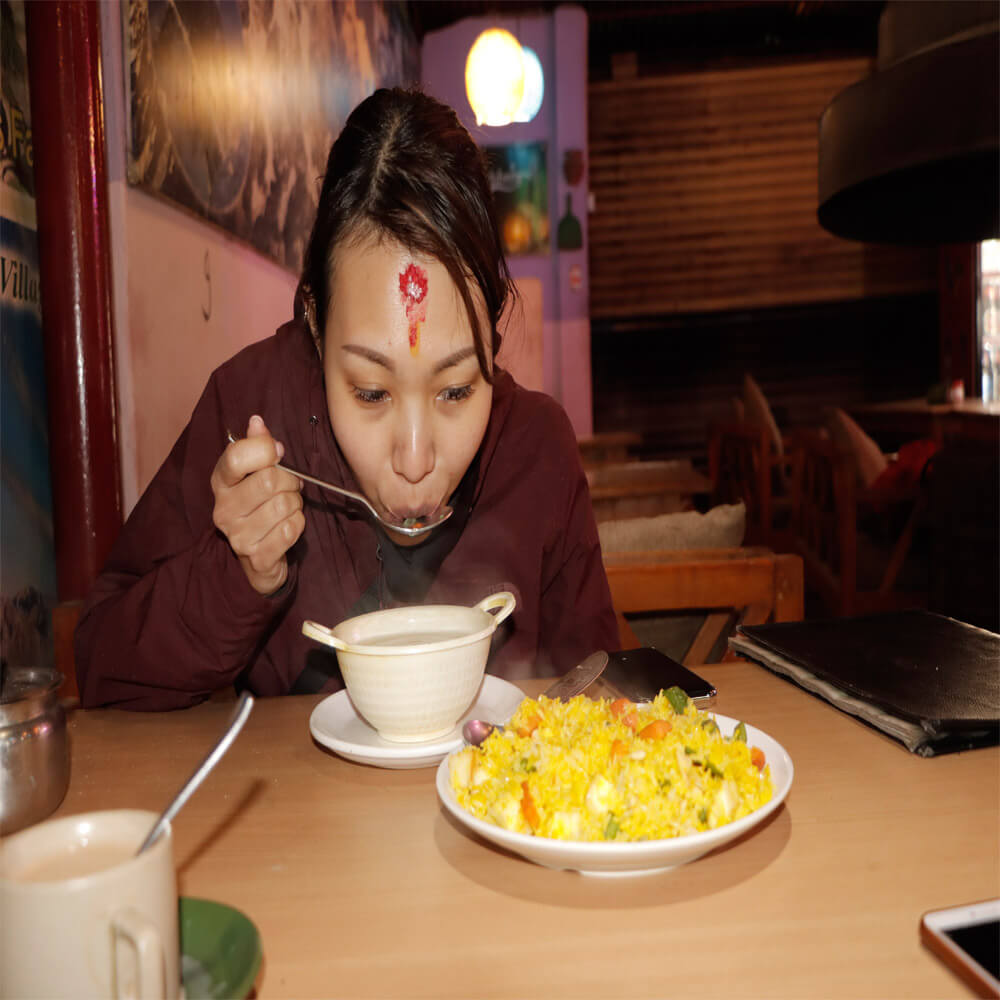
During a trek, a guide is someone who goes alongside you and helps you locate the correct trekking route. Additionally, they include information about the area culture, communities, and mountain names. A guide for the Ghandruk Circuit Trek often charges between $25 and $30 USD each day. The cost covers their lodging, meals, and other expenses. Particularly if you are trekking for the first time or with your family, guides make your trip simpler, safer, and more enjoyable.
Hiring a Porter for Ghorepani Ghandruk Trekking
A porter is a person who assists you with carrying heavy items or your backpack. This is really useful if you want to enjoy strolling without getting too weary or if your bag is heavy.
The average cost of a porter is between $20 and $25 USD per day. Two persons can share a porter if their bags are light, as one porter can carry up to 20 to 25 kilograms.
Tipping the Guide and Porter
Tipping your guide and porter at the end of the trek is considered kind and considerate. Tipping is not required, but it does express gratitude for their assistance. A modest gratuity of 10% of the entire salary is a kind way to express gratitude.
Booking through an Agency
We will set you up with a good guide or porter if you reserve your trek through our company. Due to the guides' training and familiarity with the routes, this is a safe and simple experience. They prepare, trek, and assist you in enjoying the trip, so you do not need to worry about anything. If you want to travel stress-free, this is a terrific option.
Gear and Equipment Expenses
What You Need for the Trek
Although you do not need a lot of specialized equipment for the Ghorepani Ghandruk Trek, wearing the appropriate clothing and other items will keep you warm and comfortable. You will need a warm jacket, a hat, gloves, and a good pair of trekking shoes because the trek climbs to Poon Hill, where it can get chilly in the morning. Additionally, you should pack a small backpack to carry your belongings during the day and a raincoat in case it rains.
Buying vs. Renting Gear
Do not worry if you do not already have trekking clothing and equipment. In Pokhara, you may rent or buy everything you need. There are numerous stores that offer low-cost daily rentals of trekking poles, sleeping bags, and jackets.
If you are only going on one trek and do not want to bring everything with you, renting is a smart choice. However, it could be wiser to purchase your own equipment if you intend to trek more in the future.
How Much the Gear Costs?
Equipment rental is less expensive than purchase. Renting a warm jacket might run you between $1 and $2 per day. The price of a sleeping bag can be comparable as well. Renting or purchasing a trekking pole is typically extremely affordable. Purchasing all of your clothing and equipment from scratch will cost more, perhaps $100 to $200.
Packing Carefully
You should not bring too much stuff. Do not bring more than you need. Packing light will allow you to enjoy walking more. Although a porter can assist with carrying your suitcase if you hire one, it is still a good idea to keep things simple. Your walk will be safer, warmer, and much more enjoyable if you have the proper equipment!
Other Expenses
Charging, Hot Showers, and Wi-Fi
Little things like charging your phone or having a hot shower are not always free while you are walking in the mountains. You will need to pay a little fee at many teahouses in order to charge your camera or phone. The reason for this is that they rely on solar energy or small generators, which are more difficult to obtain in the highlands.
Additionally, taking a hot shower is expensive, typically costing several hundred rupees. After a long day of walking, especially in cold weather, it feels great. Some places could offer you a pail of warm water rather than a full shower. In certain teahouses, Wi-Fi is offered, but it could cost money.
Although the connection is not always reliable, it allows you to send your family a picture or a message. Despite their low cost, these items add up over the course of the journey.
Water, Snacks, and Tips
When walking, it is crucial to have clean drinking water. Many villages sell bottled water, but it can be pricey. It costs more the higher you go. Bringing a water filter or purification tablets is a better idea. In this manner, you can purify the water yourself and fill your bottle with water from nearby faucets or rivers. In addition to saving money, it benefits the environment.
Along the way, you might also wish to purchase some munchies, such chocolate, biscuits, or noodles. Compared to the city, these are more costly. Additionally, if you have a guide or porter, remember to tip them. It is a kind way to express gratitude for their help. In the mountains, even little tips make a big difference.
Ghorepani Ghandruk Trek Cost Per Person
Ghandruk Trek Budget Option (Independent Trekker)

You can save money if you want to complete the Ghorepani Ghandruk Trek without a guide or porter. This is the least expensive trekking option. You will stay in modest teahouses, ride local buses or jeeps, and eat plain meals like pancakes, noodles, or dal bhat. You will be responsible for carrying your own backpack and making your own travel plans. The primary constant expenditures are transportation from Pokhara and permit fees. Depending on how many days you walk, the average cost of the entire expedition might be between $150 and $250.
Mid-Range Option (With Guide or Porter)
You can hire a porter or a guide if you need a little extra assistance. A guide helps you feel protected, shows you the way, and shares anecdotes about the communities. To make walking easier, a porter carries your bag. Their assistance makes the trek more enjoyable and cozy. The total cost of this option is higher, ranging from $300 to $500. The price covers food, lodging, transportation, permits, and the daily fee for the guide or porter.
Ghorepani Ghandruk trek package cost (With Trekking Agency)
Booking with a trekking company like Nepal Trekking Routes is an option if you want everything handled. They set up your accommodations, transportation, food, porter, permits, and guide. You do not have to worry about anything because they take care of everything. This is the simplest and safest choice, particularly for those who have never trekked before. Depending on the amount of days and services you select, this type of comprehensive Nepal Trekking package might cost anywhere from $500 to $800 per person. All you do is unwind and take in the mountains.
Money-Saving Tips for Ghorepani Ghandruk Trek
Here are some simple suggestions to assist you save money if you want to enjoy the Ghorepani Ghandruk Trek without going over budget.
Take a small group or friends on a trip.
Walking in a group allows you to split many expenses. For instance, you can divide the cost of a taxi or jeep from Pokhara to Nayapul. Additionally, you can rent a single guide or porter and share a room in a teahouse. Everyone benefits from the cost savings.
Remember to pack your own water bottle and filter.
It might be costly to purchase bottled water while trekking. Bring a water filter or purification tablets instead, along with a reusable water bottle. Every day, you can save money by filling your bottle with safe water sources.
Rent gear in Pokhara instead of buying
You may rent trekking equipment in Pokhara if you do not already have it, such as walking sticks, sleeping bags, and jackets. Renting is ideal for a quick trek and is less expensive than buying.
Eat local food like dal bhat
A substantial, healthful lunch that is frequently less expensive than other menu items is daal bhat, which consists of rice, lentils, and veggies. In most locations, refilling it is also free! To keep the expense of your meals down, use simple items.
Trek in the off-season
You can discover less expensive lodging and more tranquil trails if you visit during off-peak times, such as early winter or late monsoon. You might be able to obtain deals on meals and accommodation, and the views might still be stunning.
You may enjoy the Ghorepani Ghandruk Trek without breaking the bank by taking these easy steps. In the highlands, you can still have a fantastic adventure!
Is the Ghorepani Ghandruk Trek Worth the Cost?
Beautiful views abound on the short and simple Ghorepani Ghandruk Trek. You see beautiful villages, snow-capped mountains, and verdant hills. It is also among Nepal's less expensive treks. Is the money worth it, though? Let us examine the price for both Indian and foreign tourists.
Ghorepani Ghandruk Trek Cost for Foreigners
- The ACAP and TIMS permits, which are required for foreign visitors, cost roughly USD 40 in total.
- Daily prices for food and lodging range from $25 to $35 USD.
- The cost of hiring a guide is between $25 to $30 each day. The cost of a porter is about $20 to $25 each day. Therefore, depending on how you travel, your total expenses for a complete trek could range from $500 to $800 USD.
Ghorepani Ghandruk Trek Cost for Indian Travelers
Indian tourists pay less for permits.
- The ACAP permit does not require a TIMS card and costs approximately INR 200.
- The daily cost of food and accommodation is almost the same, at INR 2000–3000.
- A porter might charge INR 1500 per day, whereas a guide might charge INR 2000.
- Indian trekkers should budget between INR 20,000 and 30,000 for a complete trek.
Overall, it is worth your money. You get peaceful trails, pleasant people, clean air, and breathtaking views of the mountains. The memories are invaluable, and the price is not too high. The Ghorepani Poon Hill Trek is an excellent option for a quick Himalayan trip for both Indian and foreign trekkers.
Conclusion: Ghorepani Ghandruk Trek cost
Beautiful, short, and easy is the Ghorepani Ghandruk Trek. You visit small villages, stroll through forests, see large mountains, and stand on Poon Hill to watch the sunrise. You will not have to walk for many days, and it does not cost a lot. Because of this, it is a fantastic trek for novices, families, and those with limited time.
If you want your vacation to be simple and safe, booking with Nepal Trekking Routes is a wise decision. We are a local trekking organization that assists with everything, including lodging, meals, permits, and guides. Our guides can show you interesting locations along the trail because they are familiar with it.
In addition to helping local businesses, traveling with our team is environmentally friendly. Because we handle the difficult aspects, you can enjoy your trek more. We are therefore the best option if you desire a joyful and simple excursion!
Some of Frequently Asked Question
What is Ghorepani Ghandruk Trek total cost?
Depending on how you travel, the Ghorepani Ghandruk trek cost per person typically ranges from $500 to $800. It will be more expensive if you travel with a guide or porter. It will be less expensive if you travel alone.
Do I need permits for the trek?
Indeed. Both the ACAP permit and the TIMS card are required. The overall cost of these is between $40 and $50. Before beginning your trek, you can purchase them in Kathmandu or Pokhara.
How much do food and hotels cost on the trail?
Teahouse meals range from $5 to $7 per meal, and rooms cost between $5 and $10 per night. You might spend $25 to $35 every day.
What is the cost of a Nepal visa for the trek?
To enter Nepal, you must have a tourist visa if you are from another nation. It is available in Kathmandu's airport. The cost of a 15-day visa is $30 USD and a 30-day visa is $50 USD. You also need to fill out a form and bring a passport size photo. With this visa, you can travel throughout Nepal and embark on the Ghorepani Ghandruk Trek.
Is airport pick-up and drop-off included in the trek cost?
Nepal Trekking Routes includes airport pickup and drop-off in the packages when you book the trip with us. When you come, someone will greet you, and when you depart, we will take you back.





